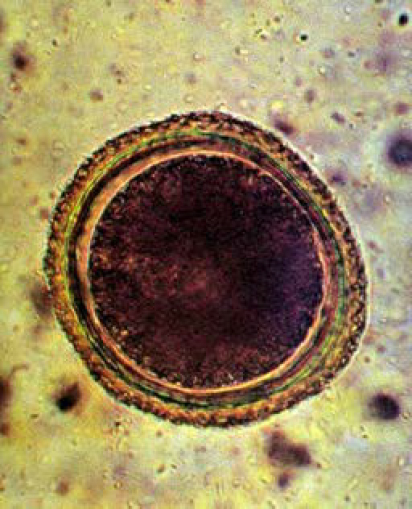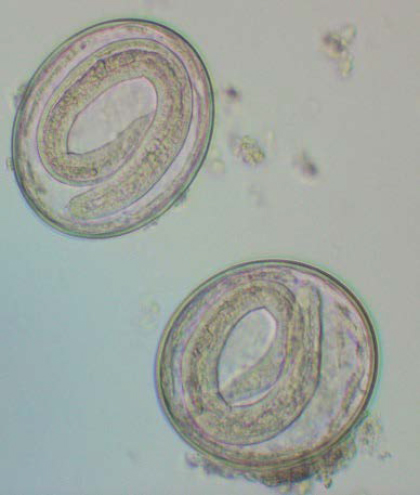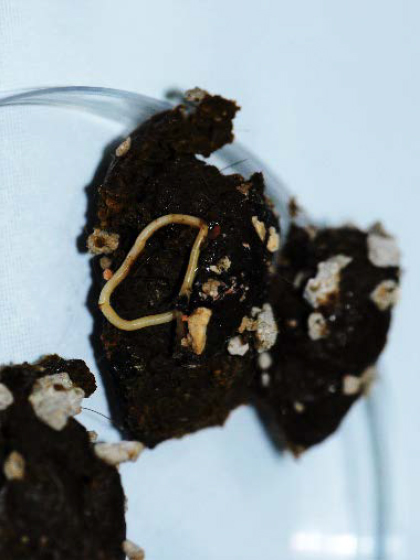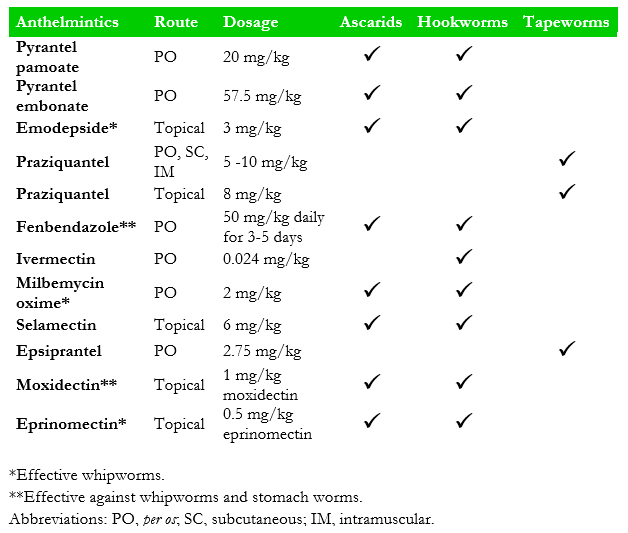Ascarids
(Toxocara spp., Toxascaris leonina)
Ascarids are nematodes that infect domestic and wild felids and can cause severe disease
in kittens. Toxocara cati is zoonotic.
Distribution
Toxocara cati and Toxascaris leonina are found worldwide [1,2]. Toxocara malaysiensis infects cats in Malaysia, China and Vietnam [3].
Clinical signs
The clinical signs depend on the burden of infection and infecting roundworm species. Toxascaris leonina and low burden T. cati infections may be subclinical. Kittens infected with T. cati, especially by the trans-mammary route, may present with cachexia, pot-bellied appearance, respiratory disorders, diarrhoea, vomiting, among other signs as early as 3 weeks of age. Heavy infections may cause intestinal blockage or intussusceptions in kittens, which are potentially fatal.

Figure 1. Toxocara cati egg showing pitted shell (Image credit: Dr. R. Traub)

Figure 2. Embryonated Toxascaris leonina eggs showing smooth shell (Image credit Dr. R. Traub)

Figure 3. Toxocara cati adult worm expelled in cat faeces (Image credit Dr. A. D. Mihalca)
Diagnosis
Ascarid infections in cats can be confirmed by standard faecal flotation (SOP 1). Eggs are unembryonated when passed, 65 μm x 77 μm and with a pitted shell in T. cati and T. malaysiensis and 70 μm x 80 μm and with a smooth shell in T. leonina [1] (Fig. 1 and 2). Creamy, spaghetti-looking worms may be observed in the vomitus or faeces of infected cats (Fig. 3).
Treatment
For anthelmintic treatment options, refer to Table 1.
Table 1. Routes of administration, dosage and efficacies of commonly utilised anthelmintics against the primary gastrointestinal parasites of cats [1,2].
Prevention and Control
Considering trans-mammary transmission and pre-patent period of T. cati, kittens need to be treated for ascarids at 3 weeks of age and fortnightly thereafter until 10 weeks of age. However, in scenarios where queens and their kittens are kept outdoors in potentially contaminated environments, kittens should be treated against hookworms starting at 2 weeks of age and then every 2 weeks until they are at least 10 weeks old. Nursing queens should be treated simultaneously with their litters. Thereafter, all cats should be treated monthly. Preventing predation and scavenging activities as well as prompt removal of faeces are also recommended.
For further control options, refer to the General Considerations and Recommendations section of these guidelines.
Public health considerations
Ingestion of embryonated T. cati eggs in the environment (soil) may produce covert, visceral or ocular larva migrans in humans. Children are most at risk. Once ingested, the larvae undergo somatic migration to organs such as the liver, lungs, brain and eyes. Such migration may be asymptomatic or alternatively incite an eosinophilic inflammatory response which may lead to signs of fever, abdominal pain, hepatomegaly and cough. Symptoms are usually self-limiting, but in some cases may lead to serious complications if there is neurological or cardiac involvement. T. cati larvae may also enter the eye and its vasculature causing decreased vision or blindness associated with chorioretinitis, optic neuritis and endophthalmitis. The zoonotic potential of T. malaysiensis remains unknown but assumed potentially zoonotic. Toxascaris leonina is not considered zoonotic.
References
[1] Bowman DD, Hendrix CM, Lindsay DS, Barr SC. Feline Clinical Parasitology. Iowa State University Press, Ames, USA. 2002.
[2] Taton-Allen G, Cheney J. Gastrointestinal parasites. In: Lappin M (ed) Feline internal medicine secrets. Philadelphia, Hanley & Belfus, 2001; p. 85-95.
[3] Le TH, Anh NT, Nguyen KT, Nguyen NT, Thuy do TT, Gasser RB. Toxocara malaysiensis infection in domestic cats in Vietnam – An emerging zoonotic issue? Infect Genet Evol. 2016;37:94-98.

